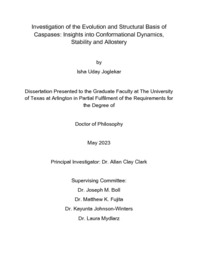| dc.description.abstract | Caspases, a class of cysteinyl proteases, are well known for their roles in apoptosis or programmed cell death. However, at lower levels of activation in the body, they also play other non-apoptotic roles in cell proliferation, cell differentiation, neuronal development, cell migration and motility, and embryonic development, all of which are poorly understood. Caspases provide an excellent model to study protein evolution since, they evolved from a common ancestral state into two subfamilies having different oligomeric properties: initiators, which exist as monomers, and effectors, which exist as dimers, under physiological conditions in a cell. However, the evolutionary basis for the divergence of the caspase-hemoglobinase fold into these subfamilies is not well understood.
Additionally, post-translational modifications (PTMs) are essential for tight regulation of caspases in cell death, and PTMs can significantly alter caspase function and promote non-apoptotic signaling pathways. Understanding these mechanisms is crucial for identifying new therapeutic targets for drug development in apoptotic cell death and associated disorders. While some PTMs such as phosphorylation and ubiquitination are well-established, the significance of others, including acetylation, are still being investigated. Understanding the mechanisms of PTMs in caspases could lead to the identification of new therapeutic targets for drug development, making this a crucial and emerging field for obtaining insights into the regulation of apoptotic cell death and associated disorders, as well as the development of effective therapies.
This study focuses on the folding landscape of monomeric caspases from two coral species, which diverged from each other about 300 million years ago and from human caspases about 600 million years ago. The research shows that both coral caspases have high stability in the physiological pH range of 6 to 8, and they unfold via two partially folded intermediates, which are in equilibrium with the native and the unfolded state. Molecular dynamics simulations, limited proteolysis, and MALDI-TOF mass spectrometry indicate that the small subunit of the monomeric caspases is unstable and unfolds before the large subunit. Similar to the dimeric caspases, the monomeric coral caspases undergo a pH-dependent conformational change resulting from the titration of an evolutionarily conserved site. The findings suggest that all caspases share a conserved folding landscape, and a conserved allosteric site can be fine-tuned for species-specific regulation. Further, instability of the small subunit of the initiator subfamily highlights the significance of the evolution of the effector subfamily of caspases, wherein the small subunit is stabilized.
This study also investigates the relationship between modest evolutionary changes in the hydrophobic core and conformational dynamics of the caspase family. Ancestral reconstruction, molecular dynamics simulations, network analysis, and free energy landscapes identify a conserved scaffold that underlies the diverse conformational dynamics of caspases across the effector and the initiator subfamilies in chordates. This study demonstrates how modular modifications in the biophysical properties of amino acids that connect the conserved scaffold to other structural elements can give rise to dynamic conformations and highlight the energetic basis of conformational fluctuations that guide the evolution of monomeric and dimeric scaffolds in protein families. Further, a conserved network of residues crucial for allosteric communication is identified. This network of residues that has been conserved over a billion years suggests that although the residues that are post-translationally modified may necessarily not be conserved across caspases, their spatial positions are, and may utilize this conserved network of residues to communicate with the active site to alter caspase function. This knowledge will help us understand how caspases fold to contribute to the fitness of an organism while maintaining or altering the energy landscape that is guided by the trade-offs between protein stability and activity. | |


